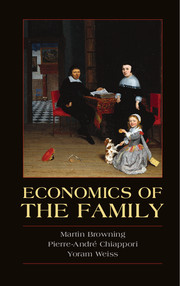Book contents
- Frontmatter
- Contents
- List of Tables
- List of Figures
- Acknowledgments
- Introduction
- PART I MODELS OF HOUSEHOLD BEHAVIOR
- 1 Facts
- 2 The Gains from Marriage
- 3 Preferences and Decision Making
- 4 The Collective Model: A Formal Analysis
- 5 Empirical Issues for the Collective Model
- 6 Uncertainty and Dynamics in the Collective Model
- PART II EQUILIBRIUM MODELS OF THE MARRIAGE MARKET
- Author Index
- Subject Index
2 - The Gains from Marriage
Published online by Cambridge University Press: 05 July 2014
- Frontmatter
- Contents
- List of Tables
- List of Figures
- Acknowledgments
- Introduction
- PART I MODELS OF HOUSEHOLD BEHAVIOR
- 1 Facts
- 2 The Gains from Marriage
- 3 Preferences and Decision Making
- 4 The Collective Model: A Formal Analysis
- 5 Empirical Issues for the Collective Model
- 6 Uncertainty and Dynamics in the Collective Model
- PART II EQUILIBRIUM MODELS OF THE MARRIAGE MARKET
- Author Index
- Subject Index
Summary
From an economic point of view, marriage is a partnership for the purpose of joint production and joint consumption. However, consumption and production are broadly defined to include goods and services such as companionship and children. Indeed, the production and rearing of children are the most commonly recognized roles of the family. But there are other important gains from marriage, both economic and emotional. Although the economic gains may not be the most important motivation for living together with someone (“marrying”), we focus on them here and examine five broad sources of potential material gain from marriage, that is, why “two are better than one”:
The sharing of public (nonrival) goods. For instance, both partners can equally enjoy their children, share the same information, and use the same home.
The division of labor to exploit comparative advantage and increasing returns to scale. For instance, one partner works at home and the other works in the market.
Extending credit and coordination of investment activities. For example, one partner works when the other is in school.
Risk pooling. For example, one partner works when the other is sick or unemployed.
Coordinating child care. This is a public good for the parents.
We emphasize that the gains discussed here are only potential – if they are realized to their full extent and who benefits from them are the subject matter of much of the rest of this book. We shall cast our discussion in terms of two agents who choose to live together, but many of the points apply generally to a many-person household. We also note that the gains for someone may be different depending on the potential partner. In later sections of this book we will expand and elaborate on many of the issues presented in this chapter.
- Type
- Chapter
- Information
- Economics of the Family , pp. 58 - 79Publisher: Cambridge University PressPrint publication year: 2014



